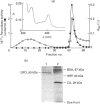Abstract
Gastric peroxidase (GPO) was purified to apparent homogeneity to characterize its major physiological electron donor. The enzyme (RZ = 0.7), with a subunit molecular mass of 50 kDa, is a glycoprotein, with a relative abundance of aspartic and glutamic acid over arginine and lysine. It has a Soret maximum at 412 nm, which is shifted to 426 nm by H2O2 due to formation of compound II. Although the physiological electron donors I-, Br- and SCN-, but not Cl-, are oxidized by GPO optimally at acid pH, only I- and SCN- are oxidized appreciably at physiological pH. Considering that the I- concentration in stomach is less than 1 microM, whereas the SCN- concentration is about 250 microM, SCN- may act as a major electron donor for GPO. Moreover, SCN- oxidation remains unaltered in the presence of physiological concentrations of other halides. The second-order rate constant for the reaction of GPO with H2O2 (k1) and compound I with SCN- (k2) at pH 7 was found to be 8 x 10(7) M-1.s-1 and 2 x 10(5) M-1.s-1 respectively. GPO has significant pseudocatalase activity also in the presence of I- or Br-, but it is blocked by SCN-. The SCN- oxidation product OSCN- may be reduced back to SCN- by cellular GSH, and GSSG may be reduced back to GSH by glutathione reductase and NADPH. In a system reconstituted with pure glutathione reductase, NADPH, GSH, SCN- and H2O2. GPO-catalysed SCN- oxidation could be coupled to NADPH oxidation. This system where GPO utilizes SCN- as the major physiological electron donor may operate efficiently to scavenge intracellular H2O2.
Full text
PDF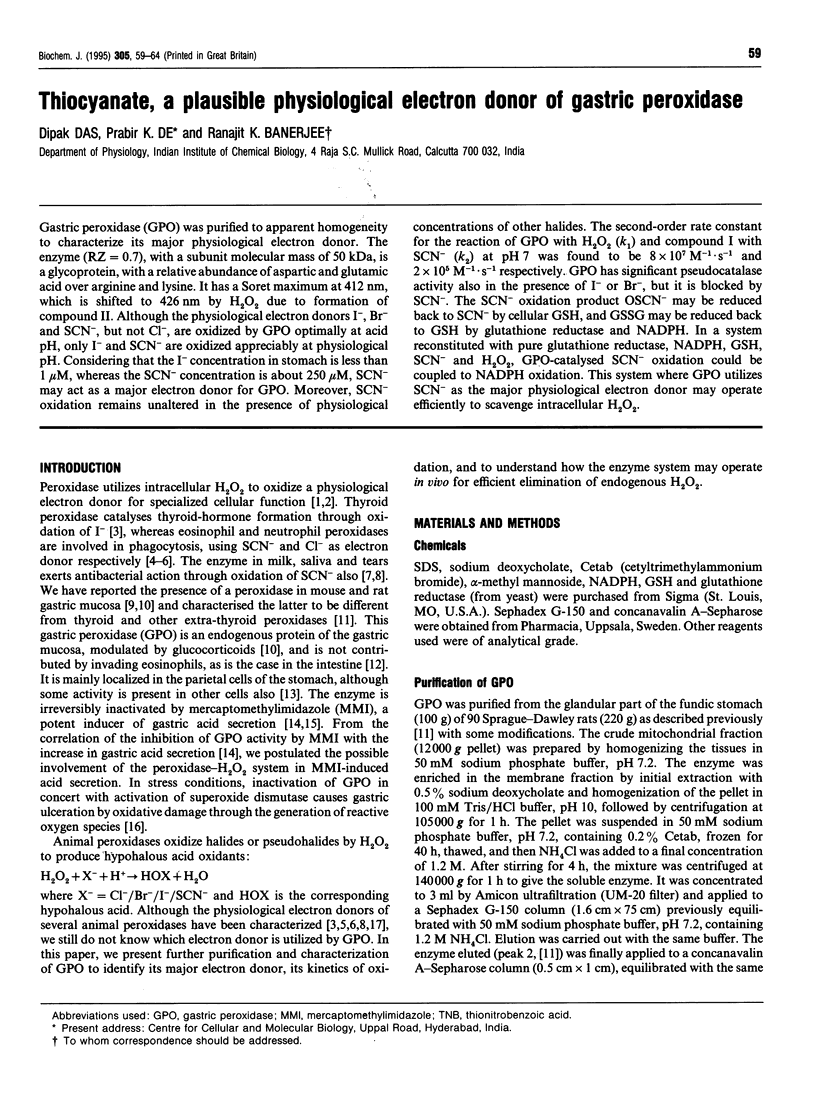
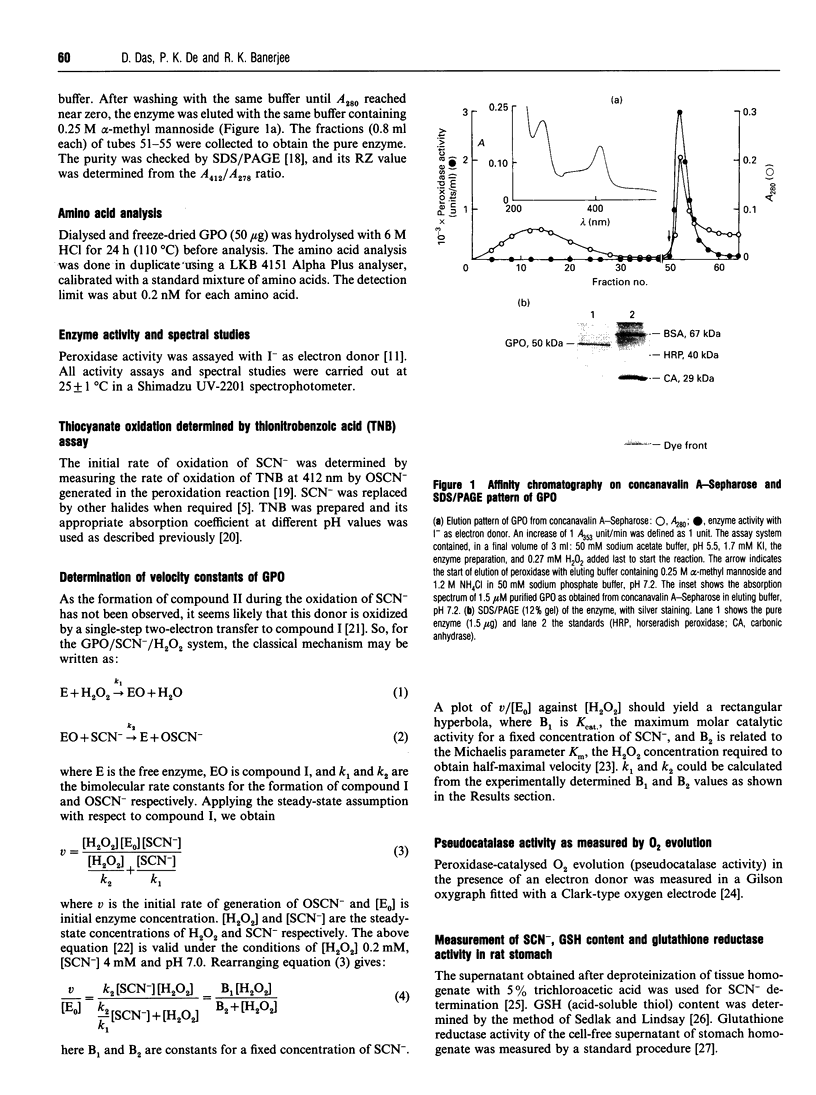
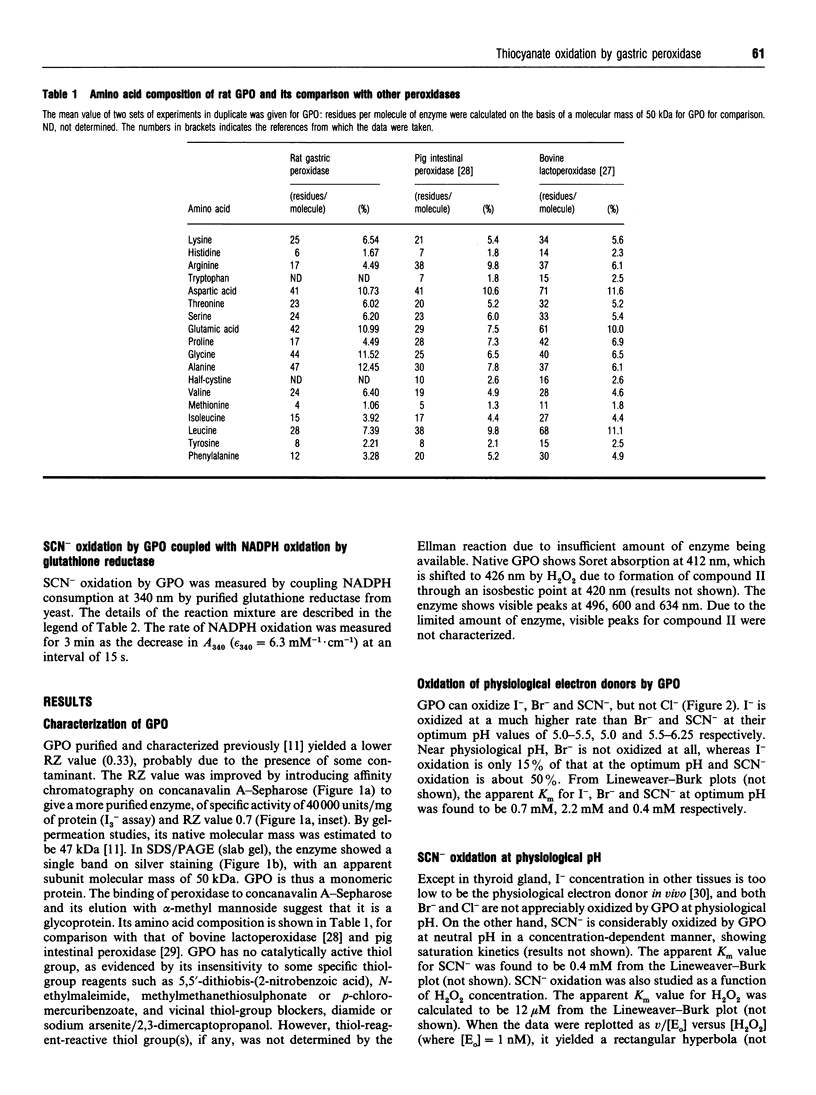
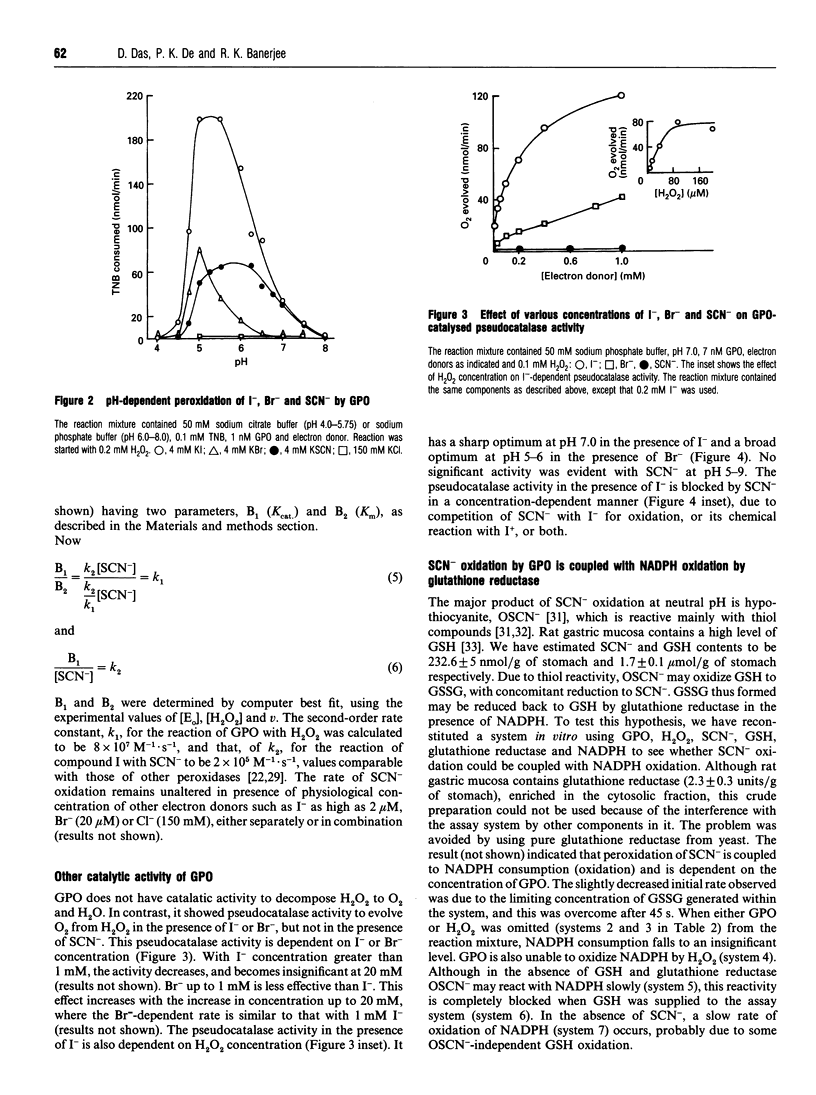
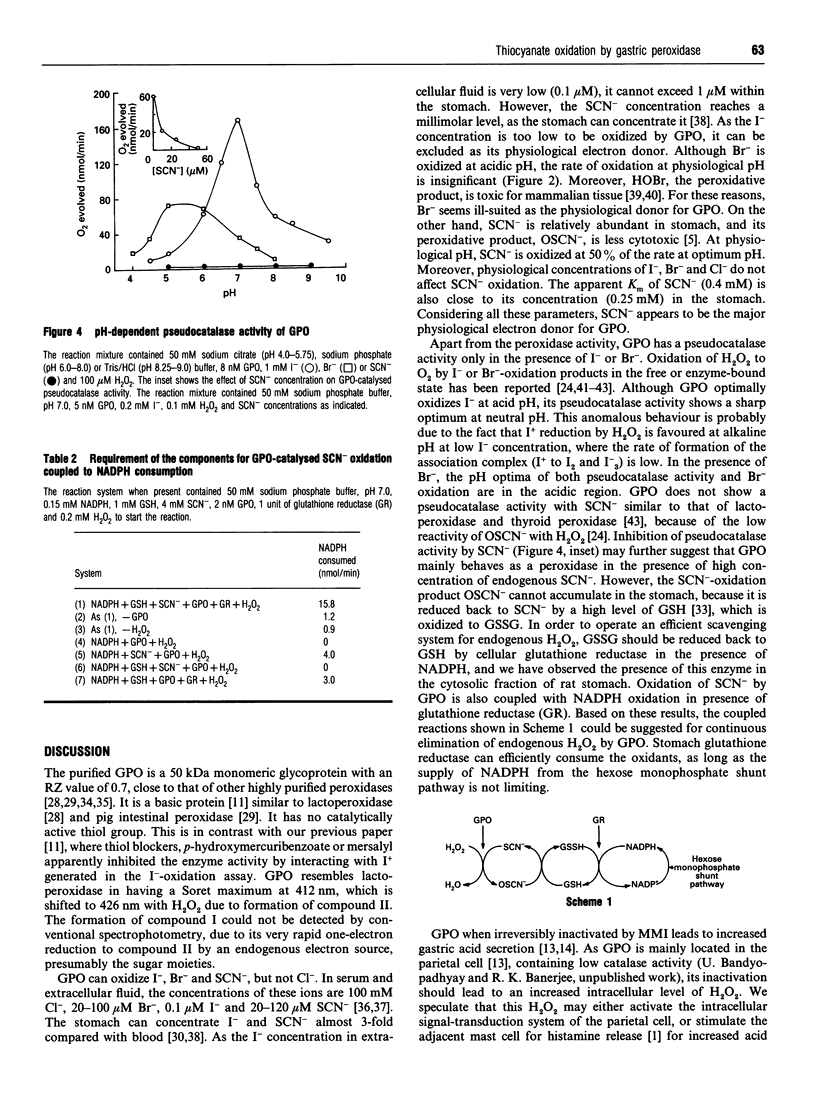
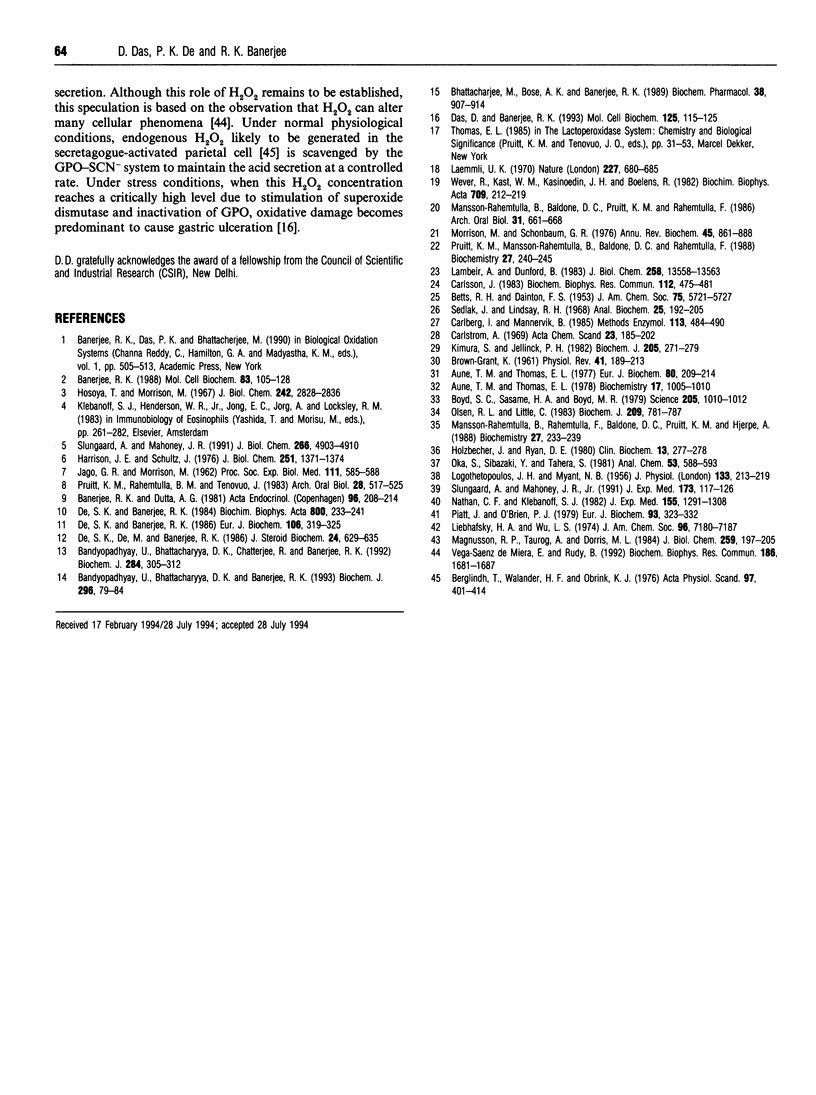
Images in this article
Selected References
These references are in PubMed. This may not be the complete list of references from this article.
- Aune T. M., Thomas E. L. Accumulation of hypothiocyanite ion during peroxidase-catalyzed oxidation of thiocyanate ion. Eur J Biochem. 1977 Oct 17;80(1):209–214. doi: 10.1111/j.1432-1033.1977.tb11873.x. [DOI] [PubMed] [Google Scholar]
- Aune T. M., Thomas E. L. Oxidation of protein sulfhydryls by products of peroxidase-catalyzed oxidation of thiocyanate ion. Biochemistry. 1978 Mar 21;17(6):1005–1010. doi: 10.1021/bi00599a010. [DOI] [PubMed] [Google Scholar]
- Bandyopadhyay U., Bhattacharyya D. K., Banerjee R. K. Mechanism-based inactivation of gastric peroxidase by mercaptomethylimidazole. Biochem J. 1993 Nov 15;296(Pt 1):79–84. doi: 10.1042/bj2960079. [DOI] [PMC free article] [PubMed] [Google Scholar]
- Bandyopadhyay U., Bhattacharyya D. K., Chatterjee R., Banerjee R. K. Localization of gastric peroxidase and its inhibition by mercaptomethylimidazole, an inducer of gastric acid secretion. Biochem J. 1992 Jun 1;284(Pt 2):305–312. doi: 10.1042/bj2840305. [DOI] [PMC free article] [PubMed] [Google Scholar]
- Banerjee R. K., Datta A. G. Gastric peroxidase--localization, catalytic properties and possible role in extrathyroidal thyroid hormone formation. Acta Endocrinol (Copenh) 1981 Feb;96(2):208–214. doi: 10.1530/acta.0.0960208. [DOI] [PubMed] [Google Scholar]
- Banerjee R. K. Membrane peroxidases. Mol Cell Biochem. 1988 Oct;83(2):105–128. doi: 10.1007/BF00226140. [DOI] [PubMed] [Google Scholar]
- Berglindh T., Helander H. F., Obrink K. J. Effects of secretagogues on oxygen consumption, aminopyrine accumulation and morphology in isolated gastric glands. Acta Physiol Scand. 1976 Aug;97(4):401–414. doi: 10.1111/j.1748-1716.1976.tb10281.x. [DOI] [PubMed] [Google Scholar]
- Bhattacharjee M., Bose A. K., Banerjee R. K. Histamine H2-receptor mediated stimulation of gastric acid secretion by mercaptomethylimidazole. Biochem Pharmacol. 1989 Mar 15;38(6):907–914. doi: 10.1016/0006-2952(89)90279-7. [DOI] [PubMed] [Google Scholar]
- Body S. C., Sasame H. A., Body M. R. High concentrations of glutathione in glandular stomach: possible implications for carcinogenesis. Science. 1979 Sep 7;205(4410):1010–1012. doi: 10.1126/science.572989. [DOI] [PubMed] [Google Scholar]
- Carlberg I., Mannervik B. Glutathione reductase. Methods Enzymol. 1985;113:484–490. doi: 10.1016/s0076-6879(85)13062-4. [DOI] [PubMed] [Google Scholar]
- Carlström A. Physical and compositional investigations of the subfractions of lactoperoxidase. Acta Chem Scand. 1969;23(1):185–202. doi: 10.3891/acta.chem.scand.23-0185. [DOI] [PubMed] [Google Scholar]
- Das D., Banerjee R. K. Effect of stress on the antioxidant enzymes and gastric ulceration. Mol Cell Biochem. 1993 Aug 25;125(2):115–125. doi: 10.1007/BF00936440. [DOI] [PubMed] [Google Scholar]
- De S. K., Banerjee R. K. Glucocorticoid effects on gastric peroxidase activity. Biochim Biophys Acta. 1984 Aug 21;800(3):233–241. doi: 10.1016/0304-4165(84)90401-x. [DOI] [PubMed] [Google Scholar]
- De S. K., Banerjee R. K. Purification, characterization and origin of rat gastric peroxidase. Eur J Biochem. 1986 Oct 15;160(2):319–325. doi: 10.1111/j.1432-1033.1986.tb09974.x. [DOI] [PubMed] [Google Scholar]
- De S. K., De M., Banerjee R. K. Localization and origin of the intestinal peroxidase--effect of adrenal glucocorticoids. J Steroid Biochem. 1986 Feb;24(2):629–635. doi: 10.1016/0022-4731(86)90130-5. [DOI] [PubMed] [Google Scholar]
- Harrison J. E., Schultz J. Studies on the chlorinating activity of myeloperoxidase. J Biol Chem. 1976 Mar 10;251(5):1371–1374. [PubMed] [Google Scholar]
- Holzbecher J., Ryan D. E. The rapid determination of total bromine and iodine in biological fluids by neutron activation. Clin Biochem. 1980 Dec;13(6):277–278. doi: 10.1016/s0009-9120(80)80009-9. [DOI] [PubMed] [Google Scholar]
- JAGO G. R., MORRISON M. Anti-streptococcal activity of lactoperoxidase III. Proc Soc Exp Biol Med. 1962 Dec;111:585–588. doi: 10.3181/00379727-111-27862. [DOI] [PubMed] [Google Scholar]
- Kimura S., Jellinck P. H. Studies on mammalian intestinal peroxidase. Biochem J. 1982 Aug 1;205(2):271–279. doi: 10.1042/bj2050271. [DOI] [PMC free article] [PubMed] [Google Scholar]
- LOGOTHETOPOULOS J. H., MYANT N. B. Concentration of radio-iodide and 35S-labelled thiocyanate by the stomach of the hamster. J Physiol. 1956 Jul 27;133(1):213–219. doi: 10.1113/jphysiol.1956.sp005579. [DOI] [PMC free article] [PubMed] [Google Scholar]
- Laemmli U. K. Cleavage of structural proteins during the assembly of the head of bacteriophage T4. Nature. 1970 Aug 15;227(5259):680–685. doi: 10.1038/227680a0. [DOI] [PubMed] [Google Scholar]
- Lambeir A. M., Dunford H. B. A steady state kinetic analysis of the reaction of chloroperoxidase with peracetic acid, chloride, and 2-chlorodimedone. J Biol Chem. 1983 Nov 25;258(22):13558–13563. [PubMed] [Google Scholar]
- Magnusson R. P., Taurog A., Dorris M. L. Mechanism of iodide-dependent catalatic activity of thyroid peroxidase and lactoperoxidase. J Biol Chem. 1984 Jan 10;259(1):197–205. [PubMed] [Google Scholar]
- Magnusson R. P., Taurog A. Iodide-dependent catalatic activity of thyroid peroxidase and lactoperoxidase. Biochem Biophys Res Commun. 1983 Apr 29;112(2):475–481. doi: 10.1016/0006-291x(83)91489-4. [DOI] [PubMed] [Google Scholar]
- Mansson-Rahemtulla B., Baldone D. C., Pruitt K. M., Rahemtulla F. Specific assays for peroxidases in human saliva. Arch Oral Biol. 1986;31(10):661–668. doi: 10.1016/0003-9969(86)90095-6. [DOI] [PubMed] [Google Scholar]
- Mansson-Rahemtulla B., Rahemtulla F., Baldone D. C., Pruitt K. M., Hjerpe A. Purification and characterization of human salivary peroxidase. Biochemistry. 1988 Jan 12;27(1):233–239. doi: 10.1021/bi00401a035. [DOI] [PubMed] [Google Scholar]
- Morrison M., Schonbaum G. R. Peroxidase-catalyzed halogenation. Annu Rev Biochem. 1976;45:861–888. doi: 10.1146/annurev.bi.45.070176.004241. [DOI] [PubMed] [Google Scholar]
- Nathan C. F., Klebanoff S. J. Augmentation of spontaneous macrophage-mediated cytolysis by eosinophil peroxidase. J Exp Med. 1982 May 1;155(5):1291–1308. doi: 10.1084/jem.155.5.1291. [DOI] [PMC free article] [PubMed] [Google Scholar]
- Oka S., Sibazaki Y., Tahara S. Direct potentiometric determination of chloride ion in whole blood. Anal Chem. 1981 Apr;53(4):588–593. doi: 10.1021/ac00227a007. [DOI] [PubMed] [Google Scholar]
- Olsen R. L., Little C. Purification and some properties of myeloperoxidase and eosinophil peroxidase from human blood. Biochem J. 1983 Mar 1;209(3):781–787. doi: 10.1042/bj2090781. [DOI] [PMC free article] [PubMed] [Google Scholar]
- Piatt J., O'Brien P. J. Singlet oxygen formation by a peroxidase, H2O2 and halide system. Eur J Biochem. 1979 Jan 15;93(2):323–332. doi: 10.1111/j.1432-1033.1979.tb12826.x. [DOI] [PubMed] [Google Scholar]
- Pruitt K. M., Mansson-Rahemtulla B., Baldone D. C., Rahemtulla F. Steady-state kinetics of thiocyanate oxidation catalyzed by human salivary peroxidase. Biochemistry. 1988 Jan 12;27(1):240–245. doi: 10.1021/bi00401a036. [DOI] [PubMed] [Google Scholar]
- Pruitt K. M., Mansson-Rahemtulla B., Tenovuo J. Detection of the hypothiocyanite (OSCN-) ion in human parotid saliva and the effect of pH on OSCN- generation in the salivary peroxidase antimicrobial system. Arch Oral Biol. 1983;28(6):517–525. doi: 10.1016/0003-9969(83)90184-x. [DOI] [PubMed] [Google Scholar]
- Sedlak J., Lindsay R. H. Estimation of total, protein-bound, and nonprotein sulfhydryl groups in tissue with Ellman's reagent. Anal Biochem. 1968 Oct 24;25(1):192–205. doi: 10.1016/0003-2697(68)90092-4. [DOI] [PubMed] [Google Scholar]
- Slungaard A., Mahoney J. R., Jr Bromide-dependent toxicity of eosinophil peroxidase for endothelium and isolated working rat hearts: a model for eosinophilic endocarditis. J Exp Med. 1991 Jan 1;173(1):117–126. doi: 10.1084/jem.173.1.117. [DOI] [PMC free article] [PubMed] [Google Scholar]
- Slungaard A., Mahoney J. R., Jr Thiocyanate is the major substrate for eosinophil peroxidase in physiologic fluids. Implications for cytotoxicity. J Biol Chem. 1991 Mar 15;266(8):4903–4910. [PubMed] [Google Scholar]
- Wever R., Kast W. M., Kasinoedin J. H., Boelens R. The peroxidation of thiocyanate catalysed by myeloperoxidase and lactoperoxidase. Biochim Biophys Acta. 1982 Dec 20;709(2):212–219. doi: 10.1016/0167-4838(82)90463-0. [DOI] [PubMed] [Google Scholar]



